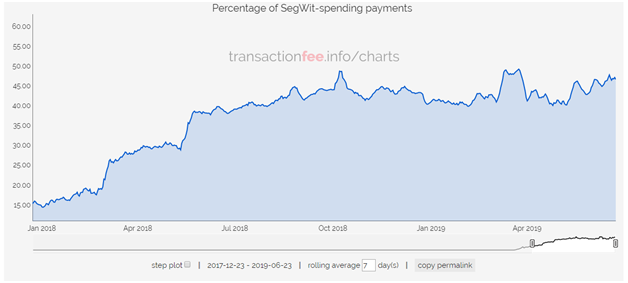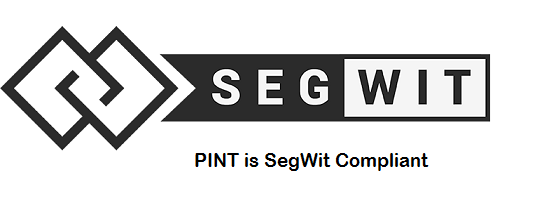What is SegWit?
With the rapid increase of Bitcoin traders and enthusiasts, the volume of Bitcoin transactions is becoming huge. The number of blocks required to store the Bitcoins is extremely high. However, these blocks can hold a limited number of transactions only because of the size constraint of 1 Megabyte (1MB). New blocks get piled in the blockchain network once a block is filled with records of transactions. This results in network congestion and slowing it down.
To solve the issue of sluggish performance of the bitcoin network, a major upgrade — SegWit (Segregated Witness) was activated in August 2017.
Essentially it is a process by which the block size limit on a blockchain is increased by storing signature data separately (or segregated) from Bitcoin transactions data. When some part of the transaction such as digital signature is removed, it frees up capacity or space to add more transactions to the blockchain network. SegWit protocol update is known to almost double the capacity of the Bitcoin network.
How SegWit Works?
Since the time SegWit update is activated for over a year now, it has changed the way information is stored and processed on the Bitcoin Blockchain. To understand how SegWit works, you must first understand how Bitcoin transactions are processed.
You can consider a Bitcoin transaction as similar to a bank check. You sign a check with some amount of money to give to someone. Similarly, a Bitcoin has a signature just like a check. It is just that instead of a physical signature, a digital signature is created using your private key.
A digital signature, also known as a witness, in Bitcoin takes up to 50% of the block space, while a signature on the physical check takes up only 10% of the check.
Further, the signature (aka witness data), usually exists in the middle of the transaction data. SegWit is a way to shift the witness data to the end of the transaction. The witness data is stripped from the transaction when a Legacy node (that hasn’t upgraded) validates a SegWit transaction. This way, transaction size gets smaller and allow more transactions per block by removing the signature from the main block of transactions.
Benefits of SegWit
- Lesser Transaction Fee
There is not enough space for all of the transactions to enter the same block when thousands of transactions are initiated at once. So, to get their transaction included in the block before others’, users have to pay a transaction fee to the miners. The transaction will go through faster, the more a user pays for his/her transaction.
Without signatures (witnesses) data on the bitcoin blockchain network, transactions weigh around 30–40% less, thus reducing the transaction fee.
- Fixes Transaction Malleability
SegWit also fixes a severe flaw in Bitcoin’s protocol that allowed users to alter the transaction id (TXID) by tampering the unlocking code of the transaction. This means any node can change the TXID before passing it on when you send your transaction into the Bitcoin network.
However, in SegWit transactions, TXID is created once all the unlocking code is moved to the end of the transaction called the witness. Hence no node will have the ability to alter the TXID of such transactions as the unlocking code is no longer part of the transaction.
- Block Weight/Capacity Increases
SegWit witness raises the block size limit to nearly 4 MB from convention 1MB block size limit. Users using wallets with SegWit support upgraded will be able to take advantage of the increased block size by shifting signature (witness) data to the last section of the transaction. SegWit also results in increasing Bitcoin’s ability to process transactions.
- SegWit Adoption
Almost 40–45% of all Bitcoin transactions are now using SegWit addresses. This indicates that SegWit adoption is growing.

PINT wallet now has the full support of SegWit
We have introduced support for SegWit in our multi-asset HD PINT wallet & Marketplace considering both the block space savings and safety concerns. SegWit is now live in PINT for Bitcoin. We use Nested SegWit also known by some as Compatibility address starting with 3.
PINT allows you to send or receive from three different type of BTC addresses easily:
· Native SegWit (bech32) — addresses starts with bc1
· Nested SegWit (P2SH) — addresses starts with 3 (PINT is using this)
· Legacy (P2PKH) — addresses start with 1
Native SegWit addresses specifically work only on the Bitcoin blockchain and not for other cryptocurrencies.
Primarily, if you want lower fees when you send the BTC out, then use your SegWit address in PINT wallet to receive deposits.
Backward compatibility is another main advantage of SegWit addresses. This means that you can send funds in PINT wallet from a Bitcoin SegWit address to a Legacy Bitcoin address.
Impact on current PINT wallet users
From the user’s perspective, there is no impact on the funds they have in PINT wallet and funds are secured. PINT’s unique P2P non custodial trades now will be faster and less costly.
Read More: Ethereum 2.0- What’s Going to Change?
Conclusion
We at Bitfia Labs believe all participants on the Bitcoin network should get the benefit of SegWit as it is becoming the standard for Bitcoin transactions.
After extensive development and testing, we are launching SegWit support for our users to get them all the SegWit benefits we talked about. So for the Bitcoin transactions, we now recommend that all PINT users should shift to use SegWit addresses.
Originally published on our Medium account on 26/09/2019

